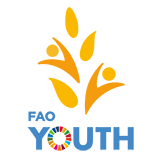Portraits of the sea: focus on sustainable fisheries

The World Food Forum (WFF) Youth Initiative in collaboration with the General Fisheries Commission for the Mediterranean (GFCM) has curated an art exhibition to be displayed at the headquarters of the Food and Agriculture Organization of the United Nations (FAO) for the second time. Showcased during the 2025 WFF flagship event, the exhibition celebrates the aquatic species of the Mediterranean and the Black Sea through a bold and immersive art installation.
Now in its second edition, the installation features larger-than-life illustrations by environmental artist Ali Elly, shining a spotlight on the importance of conserving and sustainably managing living marine resources in the Mediterranean and the Black Sea.
This year’s installation showcases some of the region’s most iconic species: blackspot seabream (Pagellus bogaraveo), blue and red shrimp (Aristeus antennatus), European eel (Anguilla anguilla), European hake (Merluccius merluccius) and giant red shrimp (Aristaeomorpha foliacea). These species were chosen for their ecological, economic and cultural importance for the region; however, they face multiple pressures that impact their populations and require careful management.
To safeguard these valuable marine resources, the GFCM applies the best available science to guide sustainable fisheries management. These efforts are supported by the development of research programmes, joint projects and management plans that reflect the distinct requirements of each species.
Blackspot seabream and European hake are both covered by management plans that ensure their long-term sustainability. The scientific basis for managing these species was strengthened through collaborative efforts to fill gaps in knowledge, as presented in a detailed analysis on Transboundary population structure of sardine, European hake and blackspot seabream in the Alboran Sea and adjacent waters – A multidisciplinary approach.
Giant red shrimp and blue and red shrimp, two valuable Mediterranean fishery resources, are managed under a series of multiannual management plans adopted by the GFCM. The findings from the comprehensive study on Giant red shrimp and blue and red shrimp in the central-eastern Mediterranean – Biology, ecology and fisheries help guide these efforts.
The European eel, an iconic species found in Mediterranean waters, is guided by dedicated management plan based on the findings of the GFCM Research programme, presented in the publication European eel in the Mediterranean Sea – Outcomes of the GFCM Research programme.
While each species requires a tailored approach, one principle remains the same: sound science leads the way. Science-based management is key to safeguarding the long-term health of living marine resources and ensuring the livelihoods of coastal communities. By investing in data, research and collaboration, the GFCM is helping to chart a more sustainable course for the region’s fisheries.
To learn more about the GFCM’s initiatives and how science is shaping the future of the Mediterranean and the Black Sea, visit www.fao.org/gfcm.
Collaboration
The GFCM is a regional fisheries management organization established under the provisions of Article XIV of the FAO Constitution. With 22 member countries and the European Union, its main objective is to ensure the conservation and the sustainable use of living marine resources as well as the sustainable development of aquaculture in the Mediterranean and in the Black Sea.




